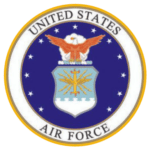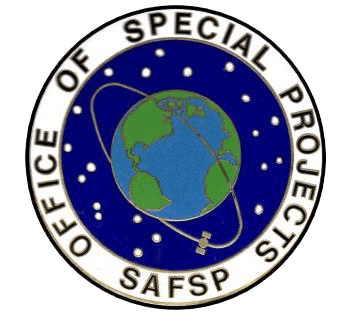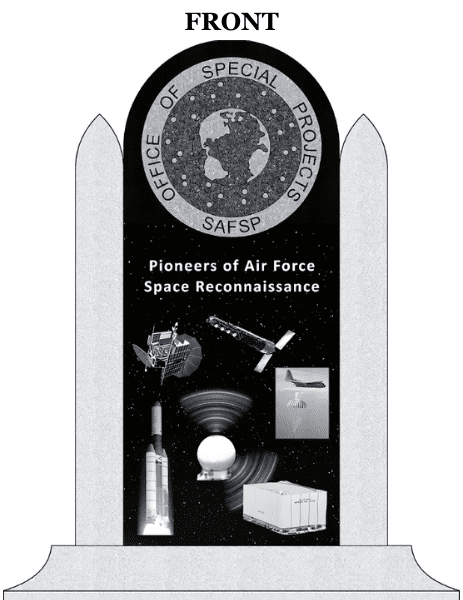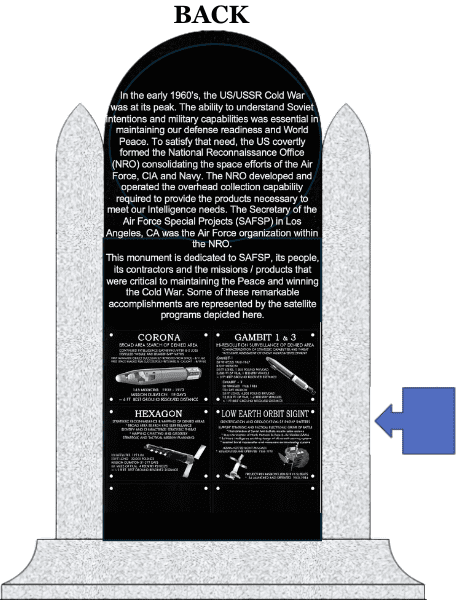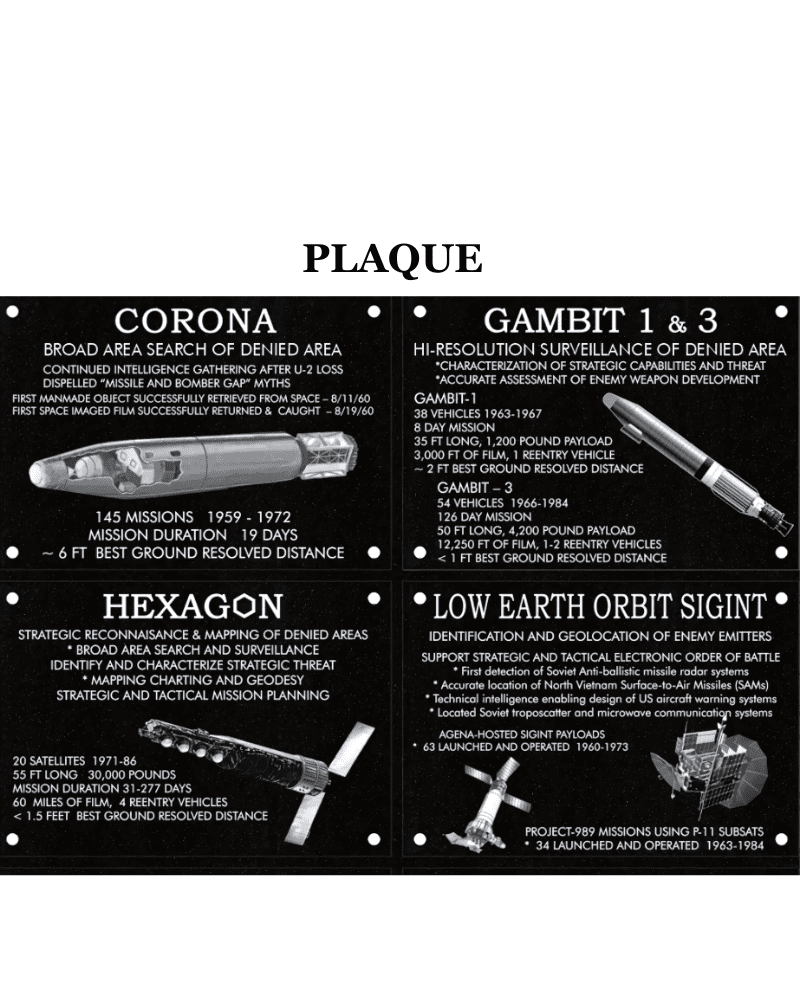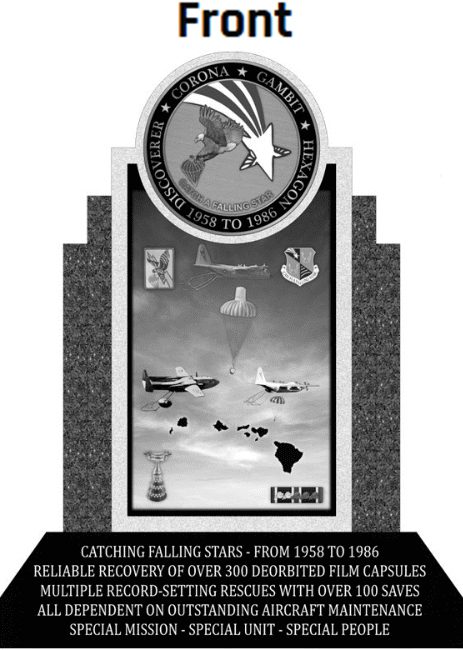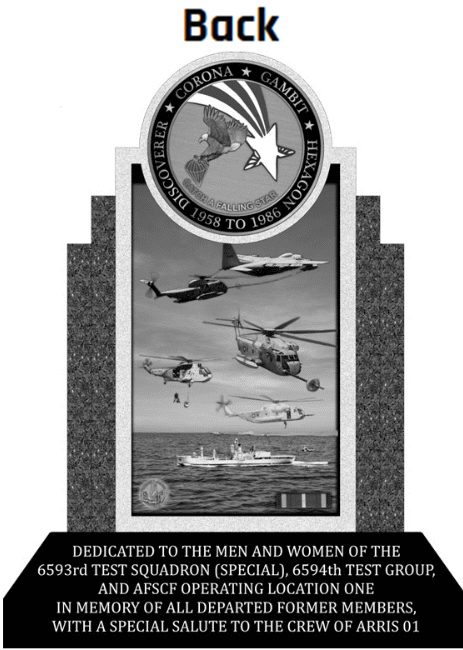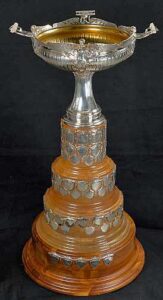PRESERVING THE HISTORY OF RECONNAISSANCE FROM SPACE
The Office of the Secretary of the Air Force Special Projects (SAFSP) Alumni Association has initiated a new program to preserve the history of SAFSP, its programs, support organizations, contractors and individuals that contributed to the mission of reconnaissance from space. This is an ambitious program and long overdue. We are asking for your financial support.
To this end, a working group of retired senior Air Force officers who managed various SP units was assembled to undertake this project. They meet regularly via on-line group internet tools, such as ZOOM. A gamut of skill sets is employed to maximize the expertise gained during their careers.
The initial History Preservation Program consists of three key tasks:
1. Design and construction of an outdoor monument/display at the National Museum of the United States Air Force at Wright-Patterson AFB, Dayton, Ohio.
2. Development of a new website that will serve two purposes. One, to aid in fund raising. Second, to be a virtual museum for relevant documents, photos, drawings, videos, individual stories and more. i.e. an accessible and searchable archive.
3. Establishment of a new corporation organized under IRS 501(c)(3) as a charity and eligible for accepting tax deductible donations.
This effort is all about the contributions made by not just the SAFSP Organization, but all the other organizations that came together to actually carry out the mission of doing space-based reconnaissance. Now unclassified, programs CORONA, GAMBIT and HEXAGON operated from 1960 thru the 1980’s, providing vital intelligence information that was crucial to the Defense of the United States during the Cold War period.
The accomplishments of these programs and others managed by SAFSP, were a testament to the creativity, dedication and skill of all the organizations and people that made it possible. This long-kept secret can now be shared with the American people. These were incredibly clever spacecraft with very high-resolution cameras. Most were literally designed with slide rules, triangles and straight edges. They performed exceedingly well and provided our nation with critical intelligence to defend the United States and its allies.
We are anxious to begin the history preservation program and invite you to join in.
Whether you served in or with the U.S. Air Force, worked for one of the Defense Contractors, want to honor a family member or friend who served, or simply share a sense of patriotism and appreciation for the role of the Air Force in our nation’s development, your gift is greatly appreciated.
THE MONUMENT
Artist Conception
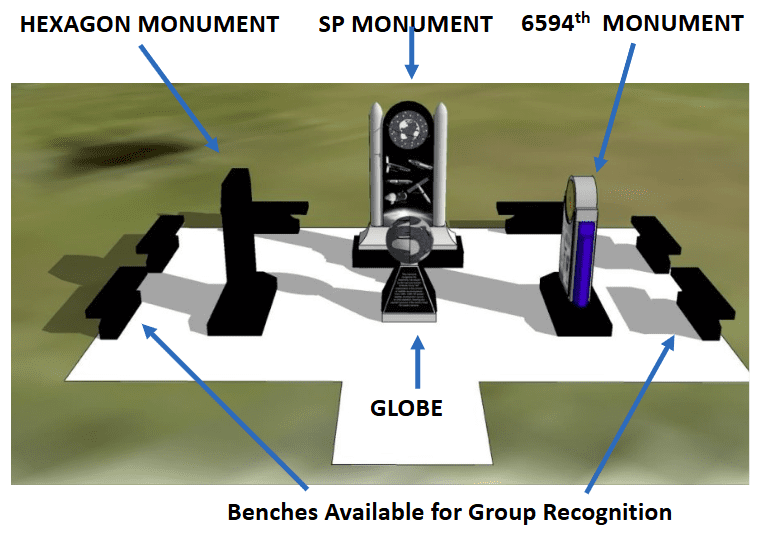
When we have collected enough funding we will proceed. We have selected a Dayton area contractor to construct the memorial to our design. It will join other memorials in the garden area just outside the museum. Here, other significant Air Force groups are honored. We will keep all donors up to date with our progress towards the unveiling date. Over 90% of the initial donations will be used to fund the memorial. The Wright-Patterson AFB site was chosen because that is where the actual GAMBIT and HEXAGON vehicles are on display to the public in the National Museum of the United States Air Force. Design concepts are in work now but the big determinant is how much money will be available to spend on the monument. The initial fund raising will provide an indication of how much we will set as a funding goal.
The monument design will lend itself to expansion for recognizing more programs as they become unclassified as well as recognizing specific organizations who are willing to contribute to a specific plaque/monument of their choosing.
MONUMENT DESIGNS
To start with, we will design and build the monuments to recognize SAFSP, declassified IMINT programs and the support organizations and contractors. Included is a separate monument honoring the 6594th Test Group – the Falling Star Catchers – for its key role in support of SAFSP’s film-based imaging programs. The HEXAGON Program will be remembered by a separate monument. Finally, a globe will tie all these together showing that these programs covered the earth to help end the Cold War. In the future, there will be opportunities to further recognize other specific organizations. The text and images on the monuments will be reviewed by the National Reconnaissance Office prior to manufacture. Pending any revisions, these images reflect the monuments going to the contractor.
Artist Conceptions
Zoom to enlarge
SP MONUMENT
HEXAGON MONUMENT
6593rd Test Squadron (Special)6594th Test GroupAFSCF Operating Location 1MONUMENT
GLOBE MONUMENT
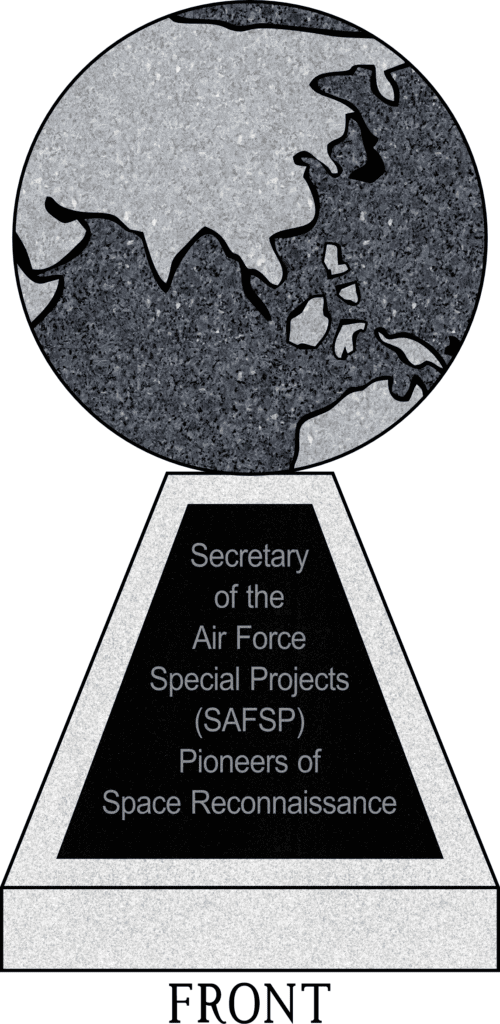
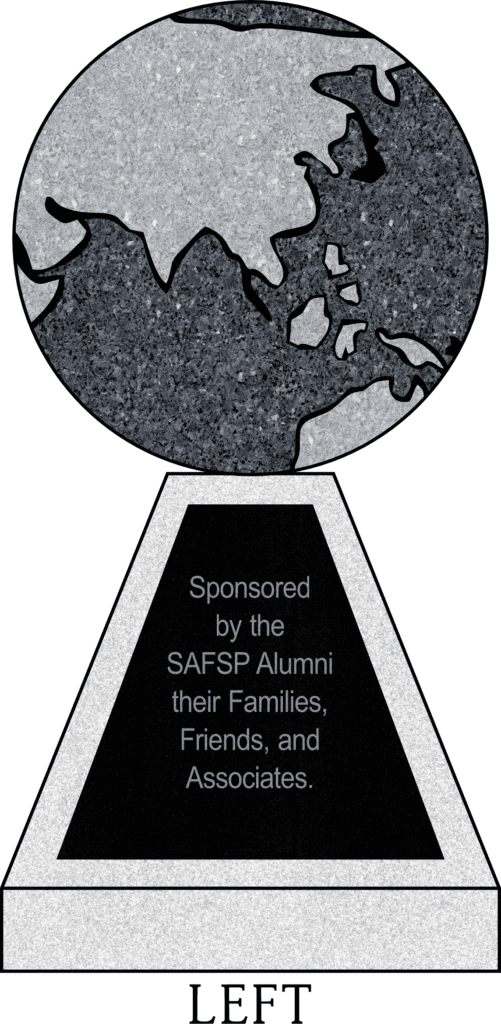
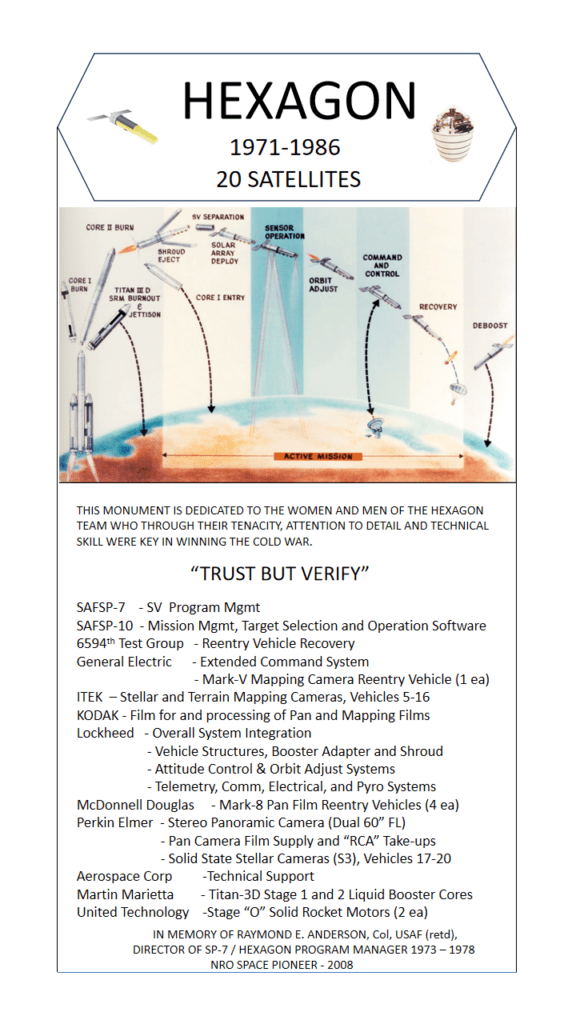
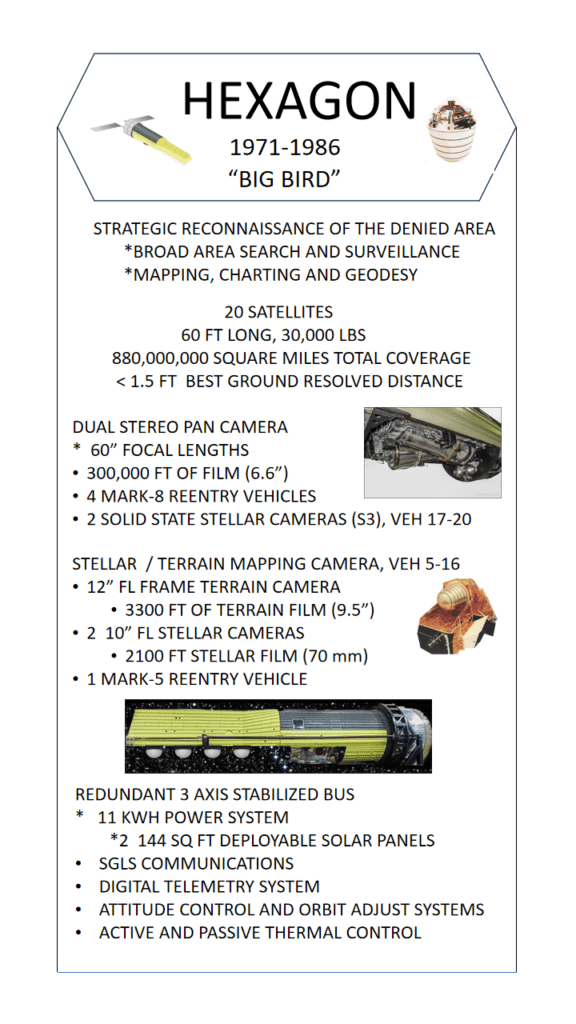
VIRTUAL MUSEUM
There are numerous public websites and YouTube’s with information about SAFSP, CORONA, GAMBIT and HEXAGON. Our intent is to collect some of this information and add to it. We’re essentially creating an archive of information. Kept under the highest security from the 1960’s through 2011, this information can now be shared. There are individual stories that can still be told. They will be captured on video through live interviews while there is still time.
It is not feasible to have a physical brick and mortar museum dedicated to reconnaissance from space. At least not now. So, we will have the concept of a “Virtual Museum” residing on this website. The design of the Virtual Museum will lead the viewer on a tour, as if the person is walking from display to display. We will describe how it all was done – we’ll explain the satellite design, production, launch, on-orbit operations and recovery of exposed film. SP will be recognized for its role in leading to these successful programs. Populating the site with documents, photos, etc. will be the job of SAFSP Heritage Fund volunteers. When the content is approved, it will be added to the website. Our goal is to create a website that will be rich in content we can all be proud of.

SAFSP HERITAGE FUND
The SAFSP Heritage Fund has been established as a California Corporation and has received IRS approval as a 501(c)(3) tax exempt public charity.
The Corporation Board is staffed by senior, retired SP leaders:
Chairman of the Board: BG (Ret) Rick Larned
President: COL (Ret) Gene Dionne
Treasurer: COL (Ret) Scott Rounce
Secretary: MG (Ret) Jim Collins
The Board members are all volunteers and receive no compensation.
Privacy Policy:
The SAFSP Heritage Fund will not sell, trade or share a donor’s personal information with anyone else, nor send donor mailings on behalf of other organizations. We only share personal information once the donor has given the charity specific permission to do so.
PRESERVING THE HISTORY OF RECONNAISSANCE FROM SPACE
The Secretary of the Air Force Office of Special Projects (SAFSP) Alumni Association has initiated a new program to preserve the history of SAFSP, its programs, support organizations, contractors and individuals that contributed to the mission of reconnaissance from space. This is an ambitious program and long overdue. We are asking for your financial support.
The initial History Preservation Program consists of three key tasks:
1. Design and construction of an outdoor monument/display at the National Museum of the United States Air Force at Wright-Patterson AFB, Dayton, Ohio.
2. Development of a new website that will serve two purposes. One, to aid in fund raising. Second, to be a virtual museum for relevant documents, photos, drawings, videos, individual stories and more. i.e. an accessible and searchable archive.
3. Establishment a new corporation organized under IRS 501(c)(3) as a charity and eligible for accepting tax deductible donations.
This effort is all about the contributions made by not just the SAFSP Organization, but all the other organizations that came together to actually carry out the mission of doing space-based reconnaissance. Now unclassified, programs CORONA, GAMBIT and HEXAGON operated from 1960 thru the 1980’s, providing vital intelligence information that was crucial to the Defense of the United States during the Cold War period.
The accomplishments of these programs and others managed by SAFSP, were a testament to the creativity, dedication and skill of all the organizations and people that made it possible. This long-kept secret can now be shared with the American people. These were incredibly clever spacecraft with very high-resolution cameras. Most were literally designed with slide rules, triangles and straight edges. They performed exceedingly well and provided our nation with critical intelligence to defend the United States and its allies.
We are anxious to begin the history preservation program and invite you to join in.
Whether you served in or with the U.S. Air Force, worked for one of the Defense Contractors, want to honor a family member or friend who served, or simply share a sense of patriotism and appreciation for the role of the Air Force in our nation’s development, your gift is greatly appreciated.
THE MONUMENT
Artist Conception
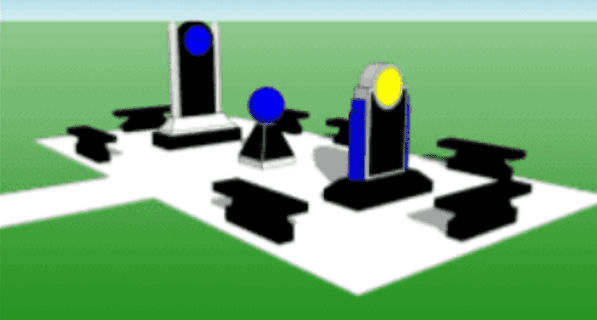
When we have collected enough funding we will proceed. We have selected a Dayton area contractor to construct the memorial to our design. It will join other memorials in the garden area just outside the museum. Here, other significant Air Force groups are honored. We will keep all donors up to date with our progress towards the unveiling date. Over 90% of the initial donations will be used to fund the memorial. This site was chosen because that is where the GAMBIT and HEXAGON vehicles are on display to the public. Design concepts are in work now but the big determinant is how much money will be available to spend on the monument. The initial fund raising will provide an indication of how much we will set as a funding goal.
The monument design will lend itself to expansion for recognizing more programs as they become unclassified as well as recognizing specific organizations who are willing to contribute to a specific plaque/monument of their choosing.
To start with, we will design and build the center of the monument display recognizing SAFSP, its three unclassified programs and all the support organizations and contractors. The next phase we will offer opportunities to further recognize specific organizations.
VIRTUAL MUSEUM
There are numerous public websites and YouTube’s with information about SAFSP, CORONA, GAMBIT and HEXAGON. Our intent is to collect some of this information and add to it. We’re essentially creating an archive of information. Kept under the highest security from the 1960’s through 2011, this information can now be shared. There are individual stories that can still be told. They will be captured on video through live interviews while there is still time.
It is not feasible to have a physical brick and mortar museum dedicated to reconnaissance from space. At least not now. So, we have the concept of a Virtual Museum residing on this website. The design of the website will lead the viewer on a tour, as if the person is walking from display to display. We will describe how it all was done – we’ll explain the satellite design, production, launch, on-orbit operations and recovery of exposed film. SP will be recognized for its role in leading to these successful programs. Populating the site with documents, photos, etc. will be the job of SAFSP.
Heritage Fund volunteers. Our goal is to create a website that will be rich in content we can all be proud of.

SAFSP HERITAGE FUND
The SAFSP Heritage Fund has been established as a California Corporation and has received IRS approval as a 501(c)(3) tax exempt public charity.
The Corporation Board is staffed by senior, retired SP leaders:
Chairman of the Board: BG (Ret) Rick Larned
President: COL (Ret) Gene Dionne
Treasurer: COL (Ret) Scott Rounce
Secretary: MG (Ret) Jim Collins
The Board members are all volunteers and receive no compensation.
Privacy Policy:
The SAFSP Heritage Fund will not sell, trade or share a donor’s personal information with anyone else, nor send donor mailings on behalf of other organizations. We only share personal information once the donor has given the charity specific permission to do so.
